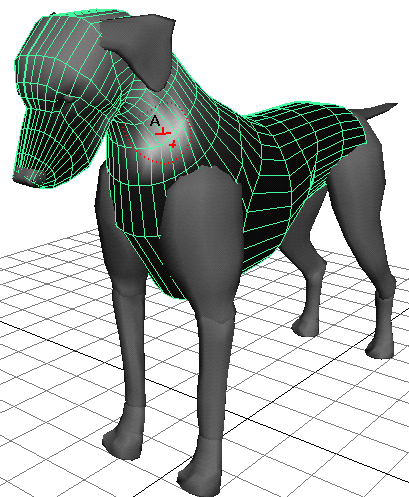
You can paint skin point weights with the Paint Skin Weights Tool. The Paint Skin Weights Tool provides an intuitive way to change the deformation effects of smooth skinning. If you want to set individual skin point weights to specific values, you can use the Component Editor (see Editing skin point weights).
 -click
on a joint and then use the up and down arrow keys on the keyboard
to navigate your character's joint hierarchy.
-click
on a joint and then use the up and down arrow keys on the keyboard
to navigate your character's joint hierarchy.
While you are painting skin point weights, you can reset the weights to their initial values at any time (see Reset skin point weights to default weights).
To explore an example that includes painting skin point weights, see Skinning a cylinder by smooth skinning.
Note that painting smooth skin point weights uses a different painting tool than the tool for painting rigid skin point weights.
Painting skin weights on masked vertices
You can create a mask on the skin that is unaffected by any weight painting you do. When you apply brush strokes over the mask, the vertices on the masked area retain their weight, regardless of the paint weights operation.
Before creating the mask you must first create the skin. For details on masking surfaces, see Restrict an area for painting.
You can copy smooth skin weights from one smooth skin object to another, or from one group of smooth skin objects to another. You can also copy skin weights on selected components of the skin.
For example, suppose you have created a team of very similar characters for a football game, and you’re at that point in the character setup process where you have just skinned them all and are about to paint the smooth skin weights to perfect the deformation effects. You first paint the weights of the quarterback. Next you have to paint the weights of all the other players. Instead of having to paint the players individually, you can copy what you did for the quarterback to each of the other players. You might then want to fine-tune the weights of the various other players, but by copying the weights you have still saved yourself a lot of time. You can focus on the creative challenges unique to the case of a particular character rather than on doing the same type of painting over and over again.
For best results, the skeleton on the character you are copying from and the skeleton you are copying to should have the same structure. If the skeletons are similar, Maya will still try to copy the weights. However, if the skeletons are radically different in scale or proportion, you may wish to:
In addition, the skeletons on each character should be in the same pose during copying. If the orientation of the joints are not similar, the copying can lack some precision, which means you may have to do some touch up painting to the results.
If the skin objects have different numbers of CVs, or if the ordering of the CVs is different, the copying will intelligently take into account the differences and provide the same type of weighting. This is very useful if you want to apply the smooth skin weighting from a high-res character to a low-res version of the character.
While you can copy skin weights between skin objects of different types, the options work best when the source object is a polygon mesh: for example, copy skin weights from a polygon mesh to a NURBS surface or a subdivision surface.
You can mirror smooth skin weights, either from one smooth skin object to another, or within the same smooth skin object. You can also mirror skin weights on selected components of the skin.
Mirroring smooth skin weights greatly speeds up the process of editing and fine-tuning skin deformation effects. For example, you could perfect the smooth skin weighting for a character’s right shoulder area and then simply mirror the weighting to the character’s left shoulder.
Maya mirrors weights across planes defined by Maya’s global workspace axis. For mirroring to work properly, the skinned object (or character) should be centered on the global axis, or at least aligned along the axes you want to mirror about. Also, the skinned object (including its skeleton) should be in a pose that is symmetrical across the mirror-plane.